A Brief, Illustrated History Of Leominster Golf Club and Course, from Beginning to 2017
Rod Garvey / 17/11/2017
Introduction
The re-formation of Leominster Golf Club is being celebrated in 2017, the golden anniversary year, so it was thought appropriate to attempt to record its history, especially still having members with first hand experience of the re-formation. This brief history has been composed with a high proportion of figures, mostly photographs but with photocopies of historic documents. As many reference documents it is rather dry but hopefully has passages of interest. It is far from complete and mentions relatively few of the members who, over the years, have made contributions to the shaping of the club and its course. Apologies are extended to any who have been overlooked or if significant events have been missed.
The Beginning and Inter-War Years
The earliest days of Leominster Golf Club are hazy. There are references to the club being “first incorporated” or “instituted” in 1903 in Kingsland and, in 1905, becoming Leominster Golf Club. There is a property called the Golf House in postal district HR6 9SF, adjacent to the line of the disused railway and in flat countryside, although the course has been described as in a forgotten location. The references imply the course at Kingsland could not have been used for long before a second course was constructed at Steens Bridge.
Golf’s Missing Links with the website, www.golfsmissinglinks.co.uk, provides a useful and solid reference to Nisbet’s Golf Year Book 1905. This is shown below in Figures 1, 2 and 3.
Figure 1

For information
21/- (or £1-5 shillings or 1 guinea) =£1.05 £2/2s/0d (or £2-2 shillings or 2 guineas) = £2.10
2/6 (or 2 shillings and sixpence or half-a-crown) = 12.5p £3/3s/0d (or 3 guineas) = £3.15
10/6 (or 10 shillings and sixpence or half a guinea) = 52.5p 1/- (or 1 shilling) = 5p
Figure 2

Figure 3
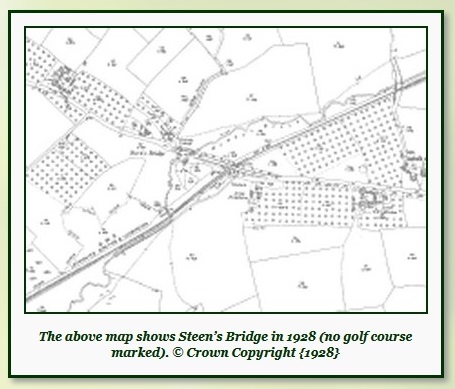
The following is an extract from the 1986 Leominster GC Handbook describing the Pre-WW II period and the Exhibition Match photographed in Figure 4.

Figure 4

In four months WW II had begun and by mid-war falling membership forced the club to cease. Attempts to revive it in 1947-48 failed and the land at Ford Bridge continued in agricultural use.
The Intervening Years
Figure 5

The pre-1967 view above is across the now 10th and 9th holes to the oak tree of the 9th tee (centre) and beyond the hedgerow to the site of the current 5th, 6th and 12th holes.
From the 1950s there were motorbike scramble meetings (Figures 6 &7) held on the land illustrated above, as recorded by member George Perry in the photographs below.
Figure 6

The large tree, top left (Figure 6), could be the oak by the 9th tee and the water-splash is probably the line of the path from the 10th green to the 11th tee below the bottom pond.
Figure 7

The large number of cars parked on the “10th fairway” show that the meetings were well attended. The 3 half-hip roof houses (top right above) can just be seen in Figure 8 (3/4 height left). Figure 8 looks from the 11th green to the 10th fairway and shows the reverse view of Figure 4. The oak tree is left of the bunker which is at the front of the 8th green.
Figure 8

The Re-Formation
In 1966 Bob Harland, Professional at Herefordshire GC, ran a series of lessons attended by Mr and Mrs Tom Helme together with the pioneers who would follow a suggestion by the Helmes to examine the site of the previous course on their land (Reference. Figure 10).
This subsequently led to the inaugral meeting of a committee at the Lamb Inn, Stoke Prior, on 16th June 1967. Hard, physical work by the members gave an initial course of 5 holes. On 8th October the first club competition was played over 9 holes, some holes being played twice. In the following year 4 more holes were opened (Figure 11).
On the 18th July 2007 Les Hollings, ex-Leominster science teacher and LGC Captain in 1975, made an audio recording of his memories of the re-formation of LGC and early work on the course and the following are extracts from its transcript.
“Jack Welsh, myself and Dave Barnes were the three that started this”. “…….Jack Welsh and I went to look at Gordon Price’s farm at Hamnish but……it was too wet and muddy”. “We……then decided to come down and look at Ford Bridge”. “……We looked……where a golf course had been 30 years earlier but not all the same land was available”. “……we held a meeting at the Talbot Hotel……”. “Nothing much was decided there and later we had a meeting with Mr and Mrs Tom Helme at their farm and they agreed to let us go ahead with trying to make a course……”……”We didn’t pay any rent……”. “Sheep and cattle would still graze and they would retain the shooting and fishing rights”……”Bob Harland, the Pro’ from Wormsley……did give us some good advice regarding the greens……”……. ” When we started cutting……we only had….. my (manual) lawnmower……”.”……The motorcyclists had……on what is now hole 10…….gouged a big channel…….” ……”…on the fairway which is now hole 2, the gorse bushes had spread all over….”…. “Once we had cleared 6 of the 9 holes we wanted, we put an advert in the local paper inviting anyone…to join our new course…, annual subscription 2 guineas. Sixty people turned up….all sixty agreed to join. We held an election…..Jack Welsh was elected Chairman, Dave Barnes ….Secretary and I …..Vice Chairman”…..” I also turned out to be Greens Superintendent…”…..”We had no Captain….and no Treasurer as we had no money”…..”…we held our meetings in the Lamb at Stoke Prior”…” we coopted other members onto the committee. Mr Wager supplied us with the old Stoke Prior cricket pavilion which had been used…as a hen house”……”Les Young… with two other volunteers built a bridge over the stream between the (now) 10th and 11th”….”Frank Dale….gave us support….He later became the first President of the club. He arranged…. to bring a gang mower used for Dale’s cricket pitch…..” “…we employed Tom Lester as a Pro’ and Steward combined”…… “To get a clubhouse, a dozen of us went to Credenhill…RAF Station to dismantle an old barrack”…..” In the end we didn’t use it but bought another structure”.
Figure 9

The above photo shows Tom Helme senior (left) at Kington GC with other KGC members R.Watkins, J.Pindar and A.Cooper.
On 29th March 1968 the Hereford Times carried the piece below.

The club made great strides in its first year. George.T.Welsh served as Captain and the notes below, (from “Leominster Golf Week 7th to 13th July 1968”) made for an exhibition match on the 9 holed course, give an insight into those exciting early days.
Figure 10

The layout of the course one year after re-formation, taken from the same document as above, is shown in Figure 11.
Figure 11

Membership of the club rose to more than 200 and LGC was elected 13th member of the Shropshire and Herefordshire Union of Golf Clubs which, in the 50th anniversary year, represented 34 clubs.
Minutes of the November 1968 committee meeting record that “…only golf shoes be worn…, as wellingtons were damaging the greens”. More significantly, around this time, there was an agreement with the landlord that cattle be excluded from the course and fences were removed from around the greens.
The first Club Championship is recorded in the following extract from the Hereford Times, Friday 10th July 1970. Robert Gunthorpe won, scored his first hole-in-one and “Gunny” went on to be the club’s most prolific champion.

The figure below, from club archives, shows information from 1971 after the erection of a clubhouse. The Hopbine Trophy is still competed as a rolling Stableford over the Easter weekend. Colin Shock went on to be Captain in 1981. The implication from Figures 11 and 12 is that Colin’s hole-in-one pre-dated that of Gunny.
Figure 12

As the club settled, success came in matches and in 1975 and 1977 the Club won the Shropshire and Herefordshire League Cup. It is likely that the photograph below was taken in celebration of the 1975 event.
Figure 12a
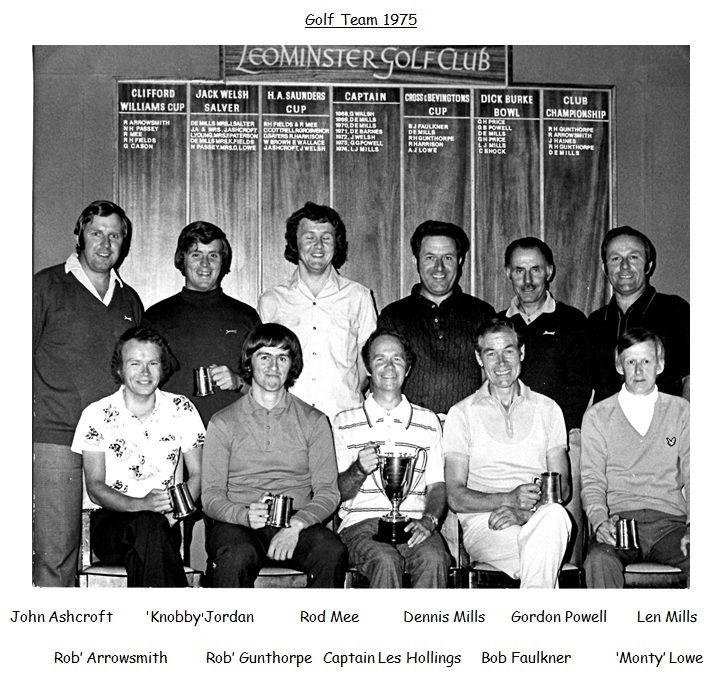
The Honours Board behind the players lists six trophies, all of which are still competed.
The photo contains five who would be Captains, one a President, three Club Champions and one who would have a trophy named after him which is still contended.
The Clubhouse
The 1986 Club Handbook gave the following description of the efforts to build a clubhouse.
Figure 13

Figure 14

The clubhouse, erected in 1969, was frequently referred to as the “chicken shed” but inside it had a pleasant, intimate atmosphere and witnessed many social evenings. The stewards lived at the left end of the building. They provided meals and staffed the bar in the central section, adjacent to the changing rooms at the right end. Much of the work on the clubhouse was carried out by members, including electrical fittings installed by Neville Passey who was one of the early members and is still playing. In 1984 the clubhouse underwent a major refurbishment in time for the Christmas Party.
Figure 14 is a photo of the clubhouse in the winter of 2000-2001 before its dismantling and sale to Bromyard Shooting Club. The roof of the new clubhouse is seen above the right gable-end and the relocated 1st hole (winter) tee.
Figure 15

Inside the old clubhouse circa mid-1980s.
Figure 16
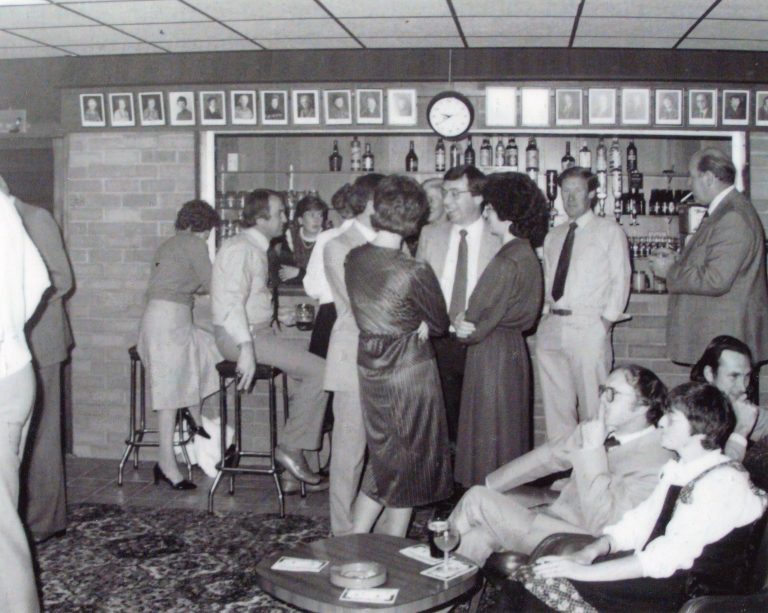
Development of the Course
In 1971 the layout of the course was changed. The configuration of Holes 8 and 17 is not clear from this copy from a 1986 Handbook which had added scribblings.

In 1978 the club obtained a license to extract water from the River Lugg and an old fire-engine (Figure 17) was purchased to water the greens; a practice which continued until the drilling of a borehole and subsequent sprinkler system. The first greens mower was also purchased in the late 1970s.
Figure 17

Loading the redundant fire-engine when sold. Beyond the rear of the engine is the site of the renowned par 3 but defunct 4th or “River Hole”.
Figure 18

The tee of the old “River Hole” which was beneath the current 11th tee and close to the workshop.
In August 1980 the club purchased the (approximately) 40 acres of land from the landlord for £80,000.
The Expansion to 18 Holes
The late 1980s afforded the opportunity to buy an extra 30+ acres from the neighbouring farmer Mr Mercer and consequently the course underwent the significant change from 9 to 18 holes. The architect of the new layout was Bob Sandow, DFC, who died in 2011. He had fought in the Battle of Britain, been a member of the USPGA, played with the famous and became a course designer. He first designed Belmont, fell in love with the county and stayed. He also designed Summerhill and the Grove and is seen (right, Figure 34 ) surveying his 6th hole, in its making, with the clerk of works.
The course, as it is today, was fundamentally shaped under the supervision of committees and members of the late 1980s and the 1990s and notable among them were John Ashcroft, David Sayers and Jack Cooper who still play competitively at the club. The practical work was driven by Head Greenkeeper Reg Gibbons and his deputy Phil’ Colebatch from 1989 into the early 1990s. It was in 1990 when a young Steve Grealy, fresh from school, joined the team.
That same year the first 36-hole club championship over the 18 hole course was won by K.Davis and the Ravenhill Cup for the best nett score over 36 holes was won by Iain Ashcroft. He is seen below receiving the trophy from Captain Ray Cooke. Iain still plays at the club, now in both main club and seniors.
Figure 18a

Following below is a series of photographs taken to illustrate the groundwork for the new 9 holes.
Figure 19
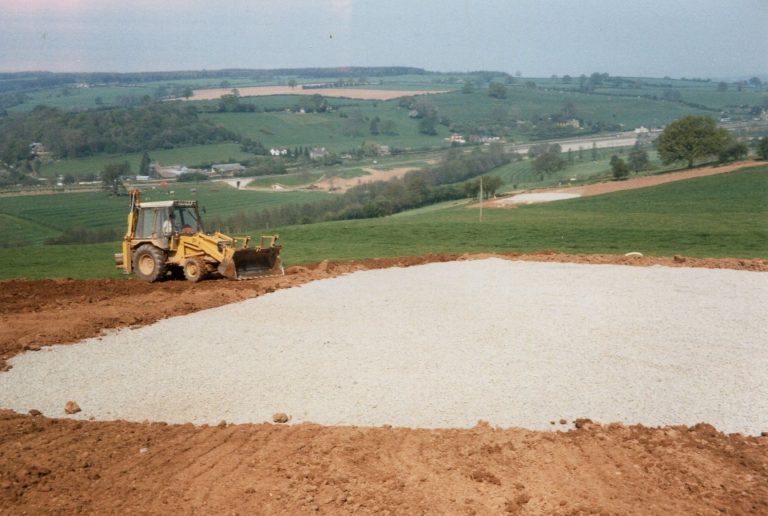
The view from the 5th green, in line with the pole of the power cables, to the 4th green. The large oak, behind the 3rd tees, is top right.
Figure 20

From the 15th green past the power lines towards the new sites for the 3rd and 12th greens. The earth mounds right are recorded as close to the site of the pre-1991 12th green near the extant willow tree seen to their left.
Figure 21

From the 14th green back to its tee and the construction of the 13th green.
Figure 22

Digging the path to the new 7th tee.
Figure 23
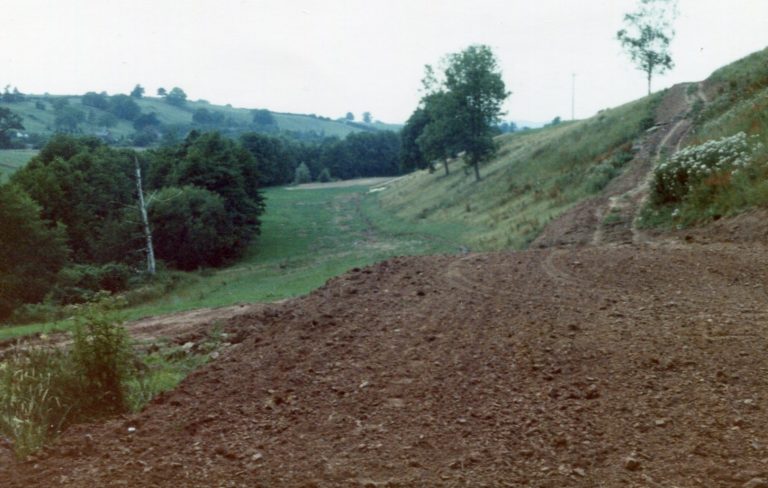
The embryonic 7th hole from its tee.
Figure 24

The 7th hole circa 1996.
Figure 25

The same view in 2017.
Figure 26

The first piles of earth to make the raised 17th green, uphill from the greensmen’s sheds. Note the new by-pass, between the river and railway, and the absence, top left, of the prominent white house seen now when playing the par 5, 4th hole.
Figure 27

Mixing the sand and soil to be used for the top layer of the new 17th green.
Figure 28

The maturing of a golf course is a natural but slow process. This shows the newly seeded 4th and 12th fairways with the 5th green behind the lady. The tractor is beneath the 3rd oak which lies between the 4th and 12th fairways and the powerline pole is on the 12th.
A similar view today is shown below.
Figure 29

Figure 30

This view is from one of the furthermost parts of the course across its newly planted trees to the agricultural land beyond which, in the new Millennium, became the second 9 hole course of the Grove. The large tree, right of centre, is the oak on the right-hand side of the 14th hole and the green mound, middle right, is the 16th tee. To protect players on that tee a fence was erected with a conifer hedge.
Further Developments
Figure 31

Figure 32

The enveloped fence at the 16th tee and mature trees in 2017.
Figure 33

In 1991 the 12th hole was extended by moving the green to the extremity of the course. This picture is from the back of the re-sited 12th green as it was being constructed in March.
It was also later decided to replace the par 3, 6th hole with that which now exists. The work was completed in 1999 but, at the December AGM, the Greens Chairman reported that, although turfed, it would not be in play until absolutely ready.
Figure 34

The “old” 6th under construction with Bob Sandow close to its tee.

Figure 35The “old” 6th green and site of the tees for the replacement hole.
Figure 36

The previous 6th hole circa 1996. Note the tiny poplars behind the 3 players and which are seen in Figure 37 above the replacement 6th hole in 2017.
Figure 37

Figure 38a and b


Until the opening of the new clubhouse the Pro’ Shop was in the cabin above with the Office and 1st tee to its left. This building became the greensmen’s office.
Figure 39

The 1st fairway seen from the tee at the rear of the Office. The course then measured approximately 30 yards longer due to the shortening of the 18th whose green was in the top corner of the existing car park.
Figure 40
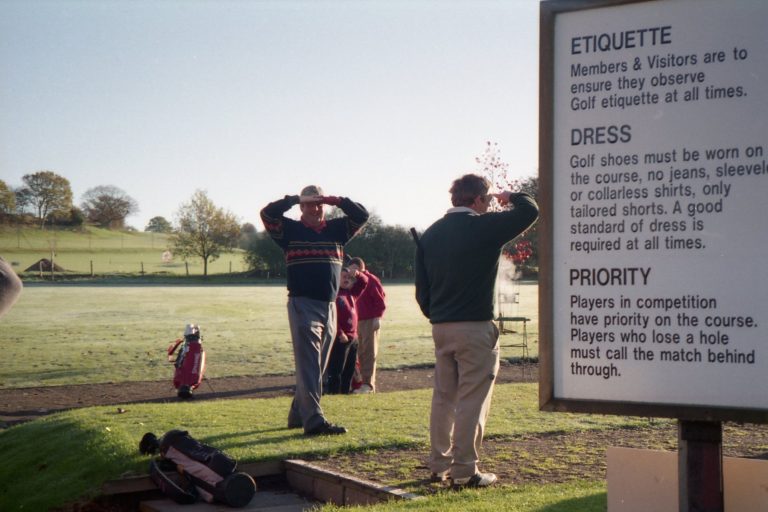
This view is across the old 18th fairway from behind the Office with the players standing on the 1st tee. The small tree to the left of Dave Strangwood’s elbow is the same as that at the left of the photo below, in Figure 41, with the current 18th green, constructed in 1998, to the right.
Figure 41

Then and Now
The richness of the mature course is well illustrated in the 6 contrasting views below. Figures 42 and 43 are from behind the 9th green towards the 1st and 18th fairways. Figures 44 and 45 are the 13th fairway; the wider views are unfortunately reduced but are still visible from many points on the course. Figures 46 and 47 show the 9th and 10th fairways from the 1st green.Where the player is walking (Figure 46) there are now 4 mature trees.
Figure 42

Figure 43

Figure 44

Figure 45

Figure 46

Figure 47

Approaching the Millennium
In 1999 the new 18th hole was opened which made space for the replacement clubhouse to be built and to extend the car park. Being significantly shortened the hole was given the two pools separated by the wall Charlie Tune built . The pools have engulfed many golf balls and trashed winning cards.
In Figure 48 the personnel in the foreground are, L-R, Ken Watson (Captain), Jack Cooper (President), Reg Gibbons (Head Greenkeeper), his deputy Phil’ Colebatch, Steve Grealy and Colin Davies.
Figure 48

Since the transforming changes during the 1990s the course has undergone only minor changes. It yielded to a record gross round in the Royal British Legion Cup in July 2000 when Jim Payne scored 65-4=61 which still stands. The 3rd tee has been moved to give the hole a slight dog-leg and the best gross competition card since this modification was that of Craig Brimmell, 19th July 2015, who shot 67-5=62 in the Ben Novus Cup. The corresponding best nett competition card was that of Chris Chadd who, on 31st July 2016 shot 71-14=57 in the Royal British Legion Cup. Perhaps the most impressive single hole played was in the Hopbine Trophy, 19th April 2014, by 21 handicapper Mark Pearson with a 6,5,4,3,2,1. He scored 6 Stableford points on the par 5, 4th hole using a 3 wood for his 2nd shot for the 1st albatross in a competition.
During 1998 plans for a new clubhouse were under active investigation and, although application for a Lottery grant had failed, the membership voted for the committee to continue its work. In 1999, at the AGM, the committee was backed in its request to proceed with the building of the new clubhouse although there were some concerns expressed. Among the membership were some with experience of the construction industry; Roger Barrington, David Pugh and ex-captain John Price notably contributed much to the project. The first sod was removed by President Jack Cooper who is seen below with, at the left, Captain Ken Watson, ex- Captain John Ashcroft and Match Secretary Bill McGrath. Also pictured, 3rd and 2nd from the right, are future Secretary Les Green and Manager Jessica Kingswood-Preece.
Figure 49

The official opening of the new clubhouse, under the captaincy of Paul Merriman, was by Nicky Lawrenson, professional golfer, ex-LGC junior, Lady Club Champion and daughter of ex-captains Phil’ and Wendy.
Figure 50

The clubhouse (below) is now well established with golf shop and good catering facilities. It is regularly used for functions of the club and the local community and frequently resounds to good craic.
Figure 51
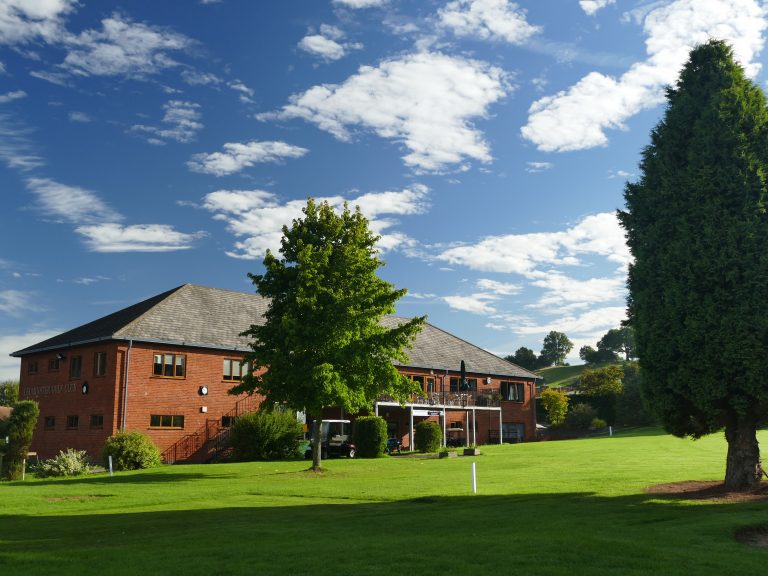
Figure 52

Subsequent to the expansion to 18 holes the most noticeable cosmetic change to the course was to harness the small stream seen in figure 5 and which ran through the significant gully crossed by the 2nd, 8th and 18th holes. In 1998 three ponds were constructed, one or two intervening on each of the holes mentioned.
The 15th hole was provided with a new white tee which makes it noticeably harder than when played from the other tees.
The most recent modification requiring movement of earth was to modify the aforementioned 3rd tee.
Figure 53

The topmost of three ponds shortly after its unexpectedly precipitate filling.
Figure 54

The same view at the height of summer 2017 and now a diverse habitat for wildlife.
In March 2004 LGC became a Community Amateur Sports Club, a government scheme, which opened the club to the whole community for provision of facilities for and participation in the amateur playing of golf. The club now has close to 400 members whose ages range from the 1st to 8th decades.
The Golden Anniversary
2017 brought the 50th anniversary of Leominster Golf Club’s re-formation. The year began with the sad news that Reg Gibbons, who practically reshaped the course, had passed away but, fittingly, his family held his wake at the place where he had such effect. Reg had won a 2 litre bottle of Scotch from the time of the old clubhouse and many shared a mellow, memorial tot. Among family and friends, 17 club captains attended to pay their respects.
Figure 56

The calendar was very full both on and off the course and the official celebration in July was a successful variety of entertainment enjoyed by a full house. Through the year there were a number of convivial evenings and memorable among them the accomplished speaker, ex-Liverpool FC’s Alan Kennedy. In keeping with the club’s ethos several charity raising events were organised on behalf of the ladies, men, seniors and whole club. The club hosted the Herefordshire Men’s Championship where members fared well in the 36 hole nett competition, taking the first 3 places. The Club Championship was won by Jamie Mee and his younger brother Will took the Ravenhill 36 hole nett competition.
In November, at the Committee Cup competition, it was a pleasure to welcome Dave Barnes, one of the 3 pioneers from 1967. He became the 4th Captain in 1971 and the Dave Barnes Cup is still competed each year in a medal competition for handicaps 0 to 18. He now lives in Shrewsbury and plays at the Wrekin Golf Club. He is pictured below (left) with David Sayers ex-President and twice Captain, his first term in 1977.

An abbreviated diary of 2017, with more details, can be found on the Club website.
Golfers no longer have to play from cattle hoof prints to hand-mown and fenced-off greens among gorse bushes. To respond to the demographic and social changes buggy paths have been laid. The course has developed into a high quality golfing test set in the beautiful Marches with extensive views. Each hole has a character of its own and is consequently memorable. Members and visitors can enjoy playing the course year-round, predominantly from grass tees to non-temporary greens which speaks well of the skills and dedication of the greens staff.




Golf in the UK and beyond has suffered a reputation of being a stuffy, expensive and exclusive game. It has seen an over-supply of courses relative to demand in the UK following pressure on farmers to diversify away from traditional activities. Golf is, in fact, an excellent outdoor sport which is good for health and fitness whilst also being very cerebral, which makes it an efficient revealer of character. With no referee it relies on the honesty and integrity of the game’s players and as a pastime has much to offer the wide population but especially young people. The administrators of the game are now encouraging shorter forms and extending the handicap range in order to enable people with time limitations to be able to join clubs and play. Members’ owned and run clubs are in a local minority, for example, in the contemporary Shropshire and Herefordshire union of Golf Clubs, more than half of the affiliated clubs are run by businesses. Golf courses are inherently expensive to maintain and this coincides with depressed earnings since the 2007-08 financial crisis and a change which has seen people become less sociable in their use of pubs and clubs of all sorts. These reasons have combined to cause the failure of a significant number of golf clubs and courses. Throughout its history Leominster GC has managed to survive periodic pressures, to the credit of its various administrators and its members, many of whom have shown a deep and lasting loyalty by making unobtrusive contributions, both material and non-material.
In the economic climate of this golden anniversary year there can be no complacency for this or any other popular golf club lest the game returns to that enjoyed by fewer numbers of players on a decreased number of courses.
The pioneers who resurrected the Ford Bridge course in 1967 deserve huge thanks both for their hard physical work and their vision. They, with subsequent generations of members, have bequeathed the people of Herefordshire and visitors with a scenic, mature facility of great value, hopefully remaining for the enjoyment of many future generations.
Appendix I

Appendix II

Appendix III

Appendix IV



